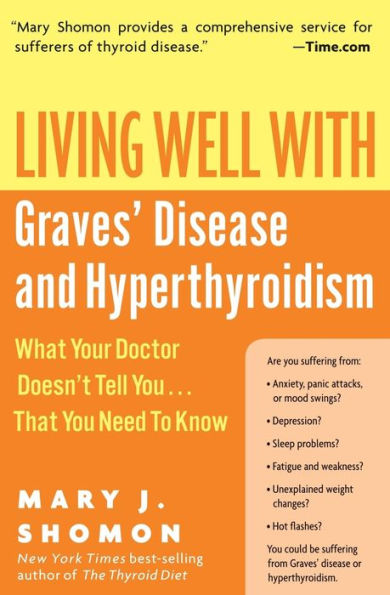There are an estimated 3 million-plus Americans suffering from Graves' disease and hyperthyroidism, and patient advocate Mary J. Shomon will guide them through the diagnosis and the wide-ranging treatments available. Graves' disease and hyperthyroidism are the result of the thyroid gland being overactive. This gland controls the body's metabolism, so people afflicted with the disorder can suffer from symptoms such as significant weight loss, fatigue, muscular weakness, and rapid heartbeat, among others. In addition to conventional treatments, this resource uniquely highlights holistic treatments, and through case studies and testimonials from patients and doctors, presents an honest look at the lifestyles and choices of people living with these conditions.
Shomon presents the reader with a comprehensive resource that spans from diagnosis to treatment to life after treatment. She goes beyond the conventional advice of other books, utilizing patient anecdotes and, as a fellow thyroid disease patient, her own experience. Her extensive network of experts—from conventional physicians to alternative practitioners—allows for a wide range of treatment options. In addition, a comprehensive Appendix serves as a fantastic resource for patients seeking treatment and additional advice.
The first edition of Living Well With Hypothyroidism (2/2000) started with a first printing of 7,500 copies and has now sold over 100,000 in the US. Shomon's The Thyroid Diet hit the New York Times extended bestseller list.
Mary Shomon has been praised by doctors around the country for her medical knowledge and sensitivity to patients' needs.
Barbara Bush brought attention to the plight of Graves' disease patients, announcing that she was suffering from it when she was First Lady.
There are an estimated 3 million-plus Americans suffering from Graves' disease and hyperthyroidism, and patient advocate Mary J. Shomon will guide them through the diagnosis and the wide-ranging treatments available. Graves' disease and hyperthyroidism are the result of the thyroid gland being overactive. This gland controls the body's metabolism, so people afflicted with the disorder can suffer from symptoms such as significant weight loss, fatigue, muscular weakness, and rapid heartbeat, among others. In addition to conventional treatments, this resource uniquely highlights holistic treatments, and through case studies and testimonials from patients and doctors, presents an honest look at the lifestyles and choices of people living with these conditions.
Shomon presents the reader with a comprehensive resource that spans from diagnosis to treatment to life after treatment. She goes beyond the conventional advice of other books, utilizing patient anecdotes and, as a fellow thyroid disease patient, her own experience. Her extensive network of experts—from conventional physicians to alternative practitioners—allows for a wide range of treatment options. In addition, a comprehensive Appendix serves as a fantastic resource for patients seeking treatment and additional advice.
The first edition of Living Well With Hypothyroidism (2/2000) started with a first printing of 7,500 copies and has now sold over 100,000 in the US. Shomon's The Thyroid Diet hit the New York Times extended bestseller list.
Mary Shomon has been praised by doctors around the country for her medical knowledge and sensitivity to patients' needs.
Barbara Bush brought attention to the plight of Graves' disease patients, announcing that she was suffering from it when she was First Lady.

Living Well with Graves' Disease and Hyperthyroidism: What Your Doctor Doesn't Tell You...That You Need to Know
448
Living Well with Graves' Disease and Hyperthyroidism: What Your Doctor Doesn't Tell You...That You Need to Know
448
Product Details
| ISBN-13: | 9780060730192 |
|---|---|
| Publisher: | HarperCollins |
| Publication date: | 09/27/2005 |
| Series: | Living Well (Collins) |
| Pages: | 448 |
| Sales rank: | 467,100 |
| Product dimensions: | 5.31(w) x 8.00(h) x 0.72(d) |
